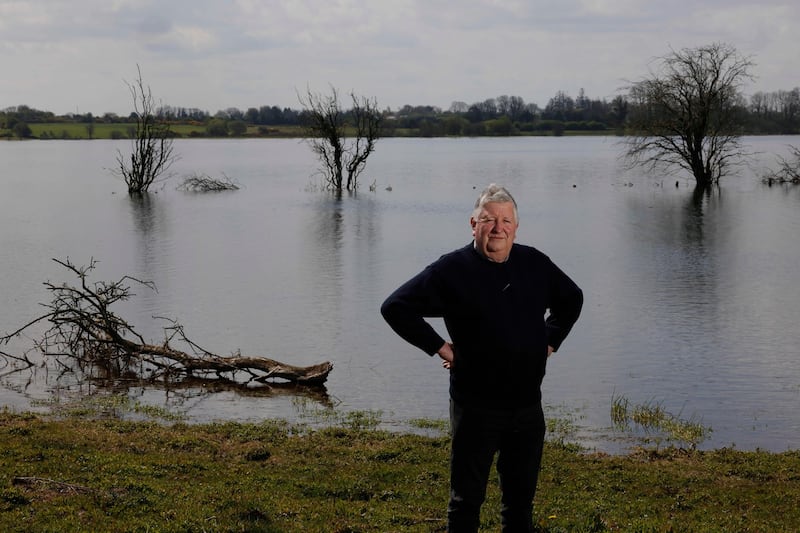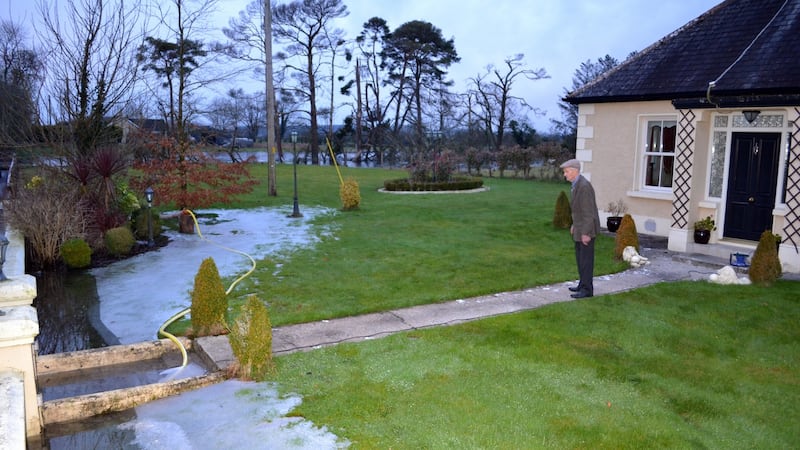The first thing Ellie McLoughlin had removed from her home near the village of Curraghboy in Co Roscommon when flood water invaded it was her 13-year-old son’s piano.
A few days ago Ellie stood with her 80-year-old neighbour Brian Fallon gazing out at the large expanse of water which has forced both of them out of their homes.
“I didn’t think it would happen so fast,” said the elderly farmer as the mother-of-three admitted that she had stopped being “bubby and optimistic” almost overnight.
The crisis at Lough Funshinagh has caused hardship for locals since 2016 and now has been recognised as one of the most pressing flood-related emergencies in the country.
READ MORE
The people in Curraghboy are shocked to find themselves at the centre of a calamity that for years has cast a shadow on those living the far side of the turlough.
Not only have two families there been forced to evacuate but at the end of this week two neighbouring houses were under threat.
“They are absolutely in bits,” says Ellie of her children aged eight, 11 and 13, explaining that her youngest is now so anxious he can’t bear to be separated from her.
After buying her beloved cottage 10 years ago, she saved for years “and borrowed a huge amount of money” to add an extension and create her dream home. Late last week water started seeping up through the bedroom floors.
On Thursday the children had to leave but she stayed another 24 hours pumping water out, as her brother and friends carried the piano, sofa and other treasured items through the treacherous flood waters.
County council staff retrieved her passports and other valuables when it was no longer deemed safe for her to enter the cottage.
[ Flooding at Lough Funshinagh forces road closures and home evacuationsOpens in new window ]
[ Roscommon lake doubles in size, threatening homes and environmentOpens in new window ]
“My life and soul went into it,” she says. “My brother put in the kitchen, the flooring was done by a family friend. It is so sentimental. It is like a part of my soul”.
But it is the impact on her children she most fears. “I do not even know how to reassure the kids. I cannot tell them we are going home because we might not be, or where we will be going. I am trying to stay strong for them.”
Flood water has not invaded the period farmhouse which Brian Fallon was born in, and which his grandfather bought in 1870, but it is inaccessible as the road leading to his home is submerged in water.
“We will have to buy a boat,” he jokes with Ellie.
“This is the generation that built Ireland,” says their son Brian. “How many recessions did they go through? I think they are due a break. But they feel forgotten about, let down. Ballagh have been dealing with this for a long time”.

The village of Ballagh on the far side of the lake – which local councillor Laurence Fallon estimated has swollen from 600 acres “at high winter flood” to more than 1300 acres now – has been suffering acutely since 2016.
Local people gathered for a wake-style vigil there when the home of the Lyons O’Meara family was demolished in 2022, 20 months after repeated flooding forced them out.
Only the tip of the garden gate can now be seen jutting out of the water, and across the road – which is now closed off – two families insist they won’t be moving out.
Edward John Beattie (85) and his wife, Teresa (83), were so upset when forced out of their home for 10 months in 2021-2022 that they decided staying put was the best option despite the council’s advice.

Last Thursday it seemed their endurance was being tested beyond reason when the power to their home was cut off for several hours meaning the electric pump keeping the water from their back door could not operate.
“There was panic as water was creeping up their drive,” says their son Matthew, chairman of the Lough Funshinagh Crisis Committee.
“They haven’t slept well for quite some time. You are conscious when you go to bed of the water a few feet away roaring to get at you. It is unsustainable.”
Fallon, the local councillor, says he knows some locals who sleep in armchairs so terrified are they that flood waters will invade their homes.
Pointing to the bank of sandbags facing the Beattie home and the house of their neighbours Mary and Padraig Beattie, he says: “If one of those bags was to move, in 15 minutes one house would have three foot of water in it, and the other would have two foot of water”.
About a kilometre away Tom Carney (72) says he woke up two weeks ago to find Storm Kathleen had brought 4ft-5ft of water into the basement of his home.
Down the road, which has been raised by 8ft to keep the water at bay, the house where his father, grandfather, great-grandfather and great-great-grandfather were all born, now has four feet of water inside.
The farmer who keeps sheep and cattle estimates that since 2016 he has lost 65 per cent of his land.
“I have gone from 12 cows down to three, and from 70 ewes to 25 this year,” he says.
The stress has taken its toll. “I haven’t a sap of energy, especially for the past two months.”
Like a lot of locals he is peeved that the court proceedings that halted the remedial work started by Roscommon County Council in 2021 was based on environmental concerns.
With the islands on Lough Funshinagh where neighbours normally share commonage now totally submerged, he uses the tips of trees protruding from the water to pinpoint Goose’s Island, “once a great nesting place”. Whitethorn trees he planted are now under several feet of water as is a stone wall he built by hand.
Matthew Beattie agrees that Lough Funshinagh is realistically no longer a Special Area of Conservation. “All the wildlife is destroyed, the hedgerows and trees are gone. The environment certainly is not gaining.”
[ Expanding lough forces elderly couple from Roscommon homeOpens in new window ]
The farmyard of 91-year-old Barry Martin is silent now. When the expanding lake filled it, along with his hayshed and lambing shed, he had to sell his entire flock of pregnant ewes. “I had no place to put them,” says Martin.
But his daughter Maria says the community has been buoyed up by the visit of recently appointed Minister of State for the OPW Kieran O’Donnell.
Her neighbour Geraldine Murray agrees that despite the crisis there is some hope, with Taoiseach Simon Harris expected to visit as early as next week.
“The excitement is palpable, as if someone has finally heard our call,” she says.
The OPW says the council has been stopped, through judicial reviews, on two occasions from undertaking and completing emergency works it had started in 2021.
The €2 million project to install an overflow pipe was intended to take away the excess water from Lough Funshinagh, to the Shannon, three kilometres away.
A spokesman said the Minister wanted to find a solution as quickly as possible, “including, if required, completing temporary works, as an emergency measure, to manage the flooding in this area.
Legal advices are being sought “to inform when works can start”.
The Friends of the Irish Environment, which took the successful court challenge halting the works initiated by the council, said the council and the OPW “have had years to develop a legally compliant scheme but have utterly failed the local residents both at Funshinagh and at Carrowmore, where the proposed exit pipe discharge threatens another community.”
- Sign up for push alerts and have the best news, analysis and comment delivered directly to your phone
- Find The Irish Times on WhatsApp and stay up to date
- Listen to our Inside Politics podcast for the best political chat and analysis














